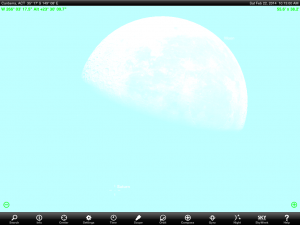Posted 16 February 2014 This post is biased towards events that can be seen with the unaided eye or via the Internet. It also can only cover predictable events. Random events such as asteroid impacts won’t be listed. Where events are time specific, I have listed the events in AEST (Australian Eastern Standard Time) and AEDT (Australian Eastern Daylight Time).
Planets: Jupiter will continue to be prominent in the early evening sky. Look above the Northern horizon at the end of evening twilight. Mars is now just under two months from opposition and is now visible low above the Eastern horizon after 10 pm AEST / 11 pm AEDT. As Earth and Mars draw closer, Mars will become noticeably brighter. Saturn rises just before 11 pm AEST / Midnight AEDT. As for Mars, look for Saturn low on the Eastern horizon. Venus is the brightest ‘star’ in the morning twilight sky. To locate Venus, look above the Eastern horizon as the sky brightens.
All week: The International Space Station is visible in the morning sky this week for Canberra, Australia. Information on passes for Canberra (with links to finder charts) can be found here. Go here for satellite viewing information / predictions for all Australian locations.
Monday 17 February 2014: 55th anniversary of the launch of the first weather satellite Vangard 2 in 1959. It was only the fifth satellite successfully launched by the United States and the first to be designed to monitor the Earth’s cloud cover. The optical scanner experiment was designed to obtain cloud-cover data between the equator and 35° to 45° N latitude. For the planned 19 days of the weather experiment, the equipment functioned normally. The satellite was spin stabilized at 50 rpm, but the optical instrument’s data was poor because of an unsatisfactory orientation of the spin axis. Vanguard 2 has an expected orbital lifetime of 300 years.
Monday 17 February 2014: Jupiter’s Great Red Spot transits Jupiter at 10:08 pm AEST / 11:08 pm AEDT.
Wednesday 19 February 2014: Mars, the star Spica and a waning gibbous Moon will form a temporary triangle in the late evening sky.
Wednesday 19 February 2014: Jupiter’s Great Red Spot transits Jupiter at 11:46 pm AEST / 12:46 am AEDT (Thursday 20 February 2014).
Thursday 20 February 2014: Morning sky. Mars and Moon close.
Friday 21 February 2014: Launch of the GPS 2F-5 global positioning satellite from the Cape Canaveral Air Force Station, Florida. The launch will be at 11:40 am AEST / 12:40 pm AEDT. Watch the webcast live here.
Saturday 22 February 2014: 7 pm AEST Minor planet Pallas at opposition
Saturday 22 February 2014: 35th anniversary of the launch of the first global positioning satellite Navstar-1 in 1978.
Saturday 22 February 2014: Morning sky. Saturn and Moon close.
Saturday 22 February 2014: Morning day sky. Saturn occulted by the Moon. Details below.
Given that this event occurs in the daytime, it will be difficult but not impossible for experienced observers to view. If you have a telescope that tracks, then you can maximise your chances of viewing the occultation by setting the telescope to track Saturn in the predawn period.
| Saturn occultation 22 February 2014 | Disappearance | Reappearance |
| Canberra (ACT) | 8:59 am AEST / 9:59 am AEDT | 10:07 am AEST / 11:07 am AEDT |
| Cairns (Qld) | No occultation occurs | No occultation occurs |
| Brisbane (Qld) | 9:12 am AEST | 10:14 am AEST |
| Gold Coast (Mermaid Beach, Qld) | 9:12 am AEST | 10:14 am AEST |
| Banora Point (NSW) | 9:12 am AEST / 10:12 am AEDT | 10:14 am AEST / 11:14 am AEDT |
| Sydney (NSW) | 9:02 am AEST / 10:02 am AEDT | 10:10 am AEST / 11:10 am AEDT |
| Melbourne (Vic) | 8:52 am AEST / 9:52 am AEDT | 10:02 am AEST / 11:02 am AEDT |
Saturday 22 February 2014: Jupiter’s Great Red Spot transits Jupiter at 9:16 pm AEST / 10:16 pm AEDT.
Sunday 23 February 2014: 3:15 am AEST / 4:15 am AEDT Last Quarter Moon
